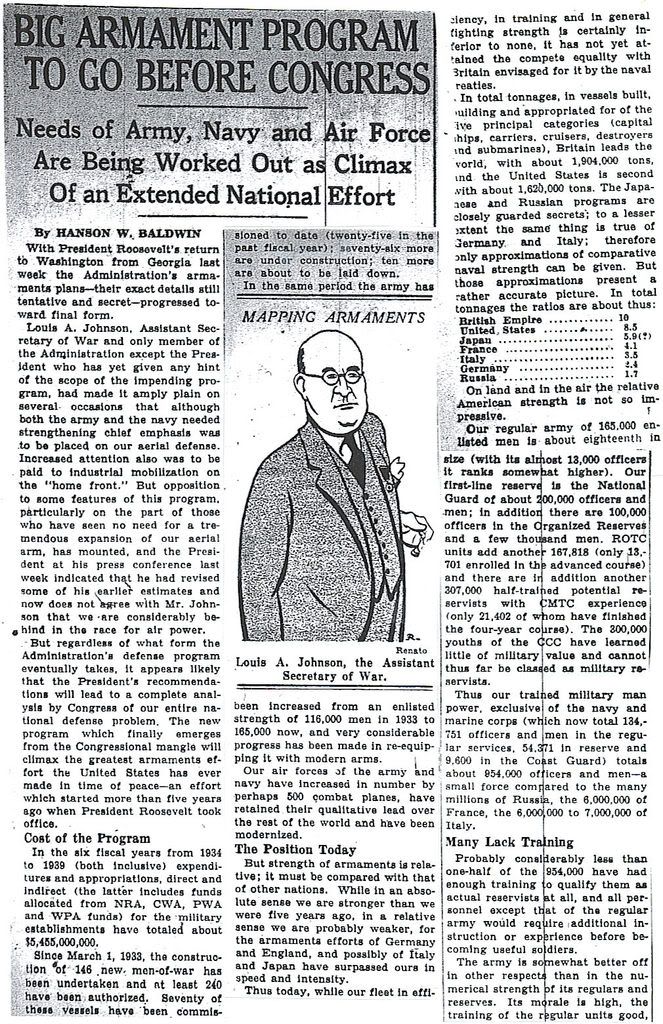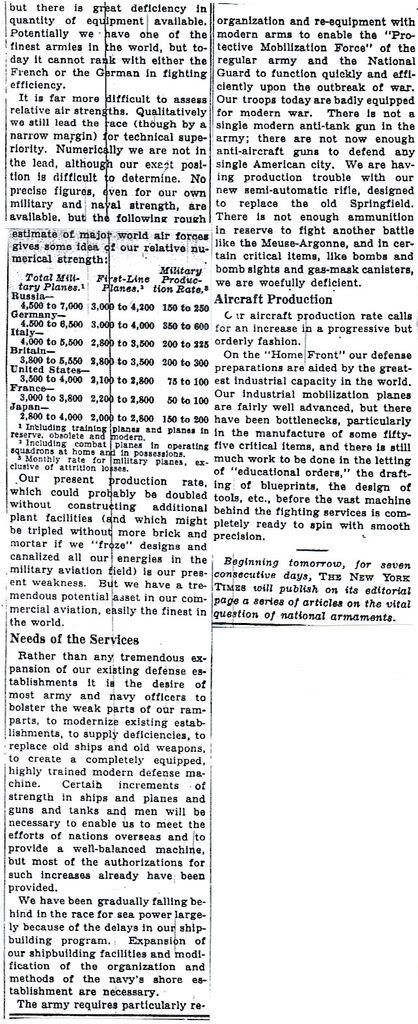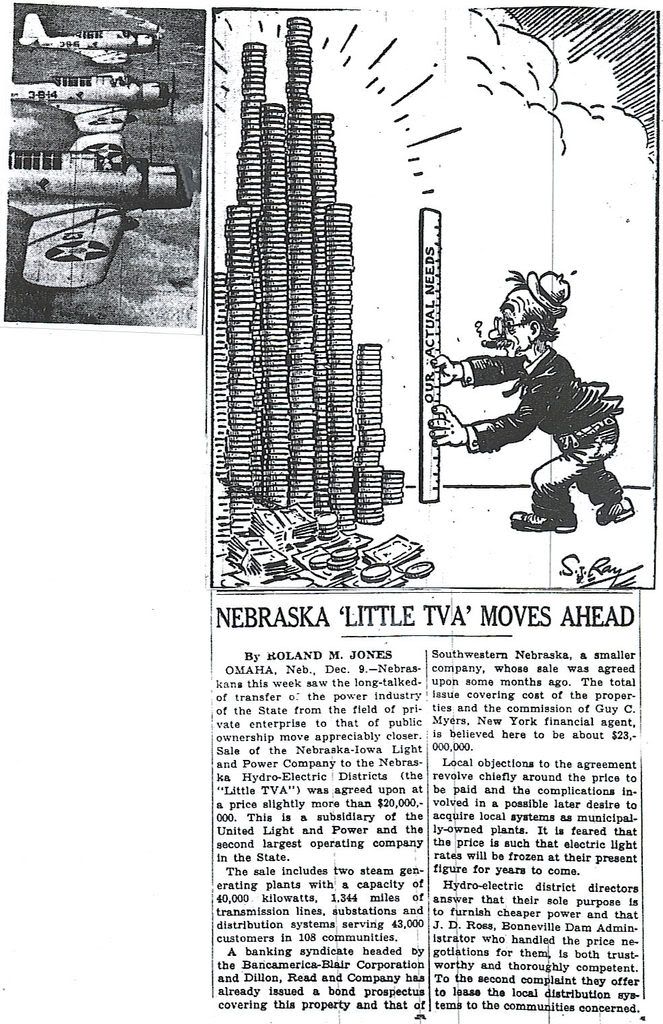
Posted on 12/11/2008 5:15:00 AM PST by Homer_J_Simpson





[Since March 1, 1933] the army has been increased from an enlisted strength of 116,000 men to 165,000 . . .
That may not be enough. It is about the number of American troops who landed in North Africa in 1942. What is the ratio of support personnel to front-line troops? Something like 3 to 1?
Somewhere I read that the planners thought we would need around 250 division. I think this was closer to 1939 or 1940. This was reduced as time passed and we ended up with around 100 divisions but NO reserves in the final stages of the war. We were not prepared for surprises at the end of the war. Thus another explanzation for the use of the atomic bomb.
George Marshall originally planned an army of 300 divisions, which we could have mobilized from the manpower available. However, there would have been corresponding cuts in manpower available for the air forces, navy and industry. Marshall did scale back to about 100 divisions (not counting the five Marine divisions). The main reason was for scaling back the army size was our commitment to coalition warfare. It was decided that we would provide material support to all our allies, and therefore manpower was diverted from the army build up to work in the industrial sector. Factories were not nearly so automated in the 1940s, and required huge amounts of labor. And when we think of Lend-Lease, we normally think of weapons shipped, but finished weapons were only a small part of the shipments.
Here’s a good website that illustrates the point in regards to lend-lease shipments to the USSR:
http://www.ordersofbattle.darkscape.net/site/sturmvogel/SovLendLease.html
The key line from this article is the idea that we were going to send all the support equipment so the USSR could concentrate on weapons production. Yes, the USSR produced massive quantities of tanks, guns and artillery pieces. On the other hand, they produced few trucks, little communications equipment, not much processed foods, etc....
All of that had to be produced somewhere, and it was produced in the USA with lots of American workers.
It was part of the strategic decision in coalition warfare that we would provide all the materials we could to our allies. The result created one of the great ironies of World War II. Stalin cut his deal with Hitler in 1939 because he thought that the allies wanted to “use” his army to fight Hitler w/o carrying their own weight (probably some truth to that). So in order to not let the Brits and French beat Hitler by spending copious amounts of Russian blood, Stalin signed the Non-Aggression Pact. He believed that the Hitler & the allies would exhaust each other and he would clean up. However, Hitler blitzkrieged the French, and then turned on the USSR. With the allies off the continent, they were in a position to offer Stalin much material aid and not take the heavy casualties. Instead, the allies defeated Hitler by spending copious amounts of Russian blood. Stalin wound up being forced to do exactly what he thought he had cleverly avoided.
This “Big Buildup” is NOTHING. Compared to what we were going to need, and what we were eventually going to produce, the amounts of money spent and materiel produced is insignificant. I suppose it was a start, and got industry thinking about how it would have to re-tool for war. Another benefit was this gave us a chance to start building modern weapons systems on a small scale so that we could work out bugs and defects. Thus, the weapons systems that went into mass production later were improved versions of “prototypes” produced from this program. Examples include the Essex class aircraft carriers, which were modified Enterprise class, and the Iowa class battleships, which were improved from North Carolina/South Dakota class ships.
The plans are “tentative and secret” but the NY Times still prints the details. LOL.
Good one. They probably publicized Gen. McClellan's secret plans to invade Virginia. Screw your country - a fine old tradition.
Slightly off topic but an interesting tidbit. Jeff Davis was Secretary of War prior to Secession. So there he was, insisting on better weapons and more men...for what would end up being the army he would fight against.
In today's terms, that would be less than $200 billion per year, or around 1/3 of our current military efforts.
And, it's interesting to consider the numbers of ships listed -- hundreds of ships, with dozens of new ones completed each year. By contrast, today's fleet is about 300 ships, with maybe a dozen new ones each year.
But total naval tonnage today is several times greater than the 1.6 million tons of 1938.
So, I think it's fair to say that by 1938, US military spending, even for the Navy, was no more than half of the effort we make today.
Oh, and by the way... did anyone else notice that not once in this whole article does the word "tank" appear?
Do you suppose that our military planners might be overlooking something?
The shopping list in the sidebar story includes: Aircraft, artillery (155 mm and 8-in howitzer), bombsights, canisters for gas masks, gas masks for horses, gas masks for civilians, AA searchlights, anti-tank guns, bombs, and fuses. No tanks.
I read an Eisenhower biography recently and learned that he and Patton, as junior officers, once disassembled an entire tank to see what made it tick. If I remember right they were interested in the use of armored force but were not encouraged by the higher brass.
"Every effort is being made to solve this aspect of the problem, and army authorities say that the answer appears in sight."
This is a fascinating discussion of the supposedly super-secret Norden bomb-sight.
You will be happy to learn that all the production problems were eventually overcome, but probably not before a certain spy passed on the design to the Germans, in 1938!

Well, well, not really...
By December 1938, the German Messerschmidt Bf109 had been flying for three years, and would see a total of 34,000 produced by war's end.
And the Japanese were also rapidly working on their new fighter -- the A6M Mitsubishi Zero -- first flown in March 1939, and eventually 11,000 produced.
Of course, I'm no expert, but would guess that both those planes were vastly superior to anything our guys were even thinking of building in 1938.
A year late and a dollar short. - ACQ
(Arm Chair Quarterback)
Oh, and you've got to love the NYT publishing the details...Pinch, you and your boys are going under. LOL!
5.56mm
Disclaimer: Opinions posted on Free Republic are those of the individual posters and do not necessarily represent the opinion of Free Republic or its management. All materials posted herein are protected by copyright law and the exemption for fair use of copyrighted works.